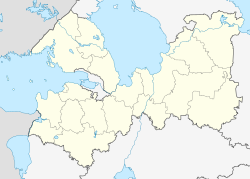Krasnoselskoye (Leningrad)
| settlement
Krasnoselskoye
Красносельское
|
||||||||||||||||||||||
|
||||||||||||||||||||||
|
||||||||||||||||||||||
Krasnoselskoje ( Russian Красносельское , formerly Красное Село / Krasnoje Selo ; Finnish Kyyrölä ) is a rural settlement (possjolok) in northwestern Russia .
geography
It is located on the Karelian Isthmus around 40 kilometers southeast of the city of Vyborg on the west bank of Vishnevskoye Lake . Krasnoselskoje belongs to the Vyborg Raion of Leningrad Oblast and is the seat of the rural municipality of the same name (selskoje posselenije), to which 20 other villages belong. The total number of inhabitants in the municipality is 5706 (as of October 14, 2010).
history
The Karelian Isthmus has belonged to Sweden since the Middle Ages , but the village of Krasnoselskoje did not exist at that time. During the Great Northern War between Russia and Sweden in 1709, heavy fighting broke out in the area of Krasnoselskoye when the Russians marched. According to legend, a stream that flows through the place is said to have turned red from the blood of the fallen, which is why the place was given the name “red village” (Russian Красное Село / Krasnoje Selo ). The following winter, the Russian troops, under the leadership of the commander Grigory Petrovich Chernyshov, had to spend in the area of Krasnoselskoye, while the Swedes had withdrawn towards Vyborg and holed up. Chernyshev is said to have taken a liking to the area during the winter and vowed to establish an estate there if he succeeded in conquering Vyborg in the spring. In fact, Vyborg fell in 1710, whereupon Tsar Peter I rewarded Chernyshev with a larger fief in the area around Krasnoselskoye.
As a founding date of Krasnoselskoje the year 1726, is considered Chernyshev after the war ended twenty serf families from the on the Volga located province of Kostroma and Yaroslavl in his lands spent and in the four villages Krasnoye Selo (today Krasnoselskoje, Finnish Kyyrölä ) Raswos (now Murawjowo , Finnish Sudenoja ), Kanki (today Iskry , Finnish Kangaspelto ) and Parkino (today Podgorje , Finnish Parkkila ). These four villages formed a Russian enclave on the Karelian Isthmus, which was then exclusively inhabited by Finnish people, and retained their language, culture and Orthodox belief. The village of Krasnoselskoye with its church was the center of an Orthodox parish. The first Finnish resident did not settle in Krasnoselskoye until 1870.
After the area of today's Finland came under Russian rule in 1809 , Krasnoselskoje was annexed as part of the so-called Old Finland in 1812 to the newly established autonomous Grand Duchy of Finland . This freed the residents of Krasnoselskoye from serfdom and gave them full Finnish citizenship. The inhabitants of Krasnoselskoye lived from agriculture and pottery. The place was known throughout Finland for its pottery made in the traditional Russian way. In 1890 the four Russian-settled villages from the municipality of Muolaa (today Prawdino ) were dissolved and obtained municipal independence as the municipality of Kyyrölä (Krasnoselskoje).
With the Finnish declaration of independence in 1917, Krasnoselskoje also became part of the Republic of Finland . While there was a Russian minority in numerous cities in the country as a result of Russian immigration while Finland was part of Russia and the flight of Russian citizens after the October Revolution , the villages of Krasnoselskoye were the only area of Finland with a closed Russian population. After independence, there were increased efforts to finance Krasnoselskoye. Russian-language teaching in schools was discontinued, and the language of the local government was changed from Russian to Finnish in 1923. In 1934 the community Kyyrölä was dissolved and incorporated again into Muolaa.
In the Finnish-Soviet winter war of 1939-40 there was fighting in Krasnoselskoye, in which the church and part of the town were destroyed. When the border was drawn after the end of the Winter War, the entire Karelian Isthmus came to the Soviet Union. In the Continuation War of 1941-44 Finland temporarily recaptured the area, but ceded it again after the end of the war. The residents of Krasnoselskoye were evacuated along with the rest of the Finnish residents of the ceded areas. The 2,000 or so refugees of Russian descent were scattered to different parts of Finland. The largest groups were settled in Hämeenlinna and Järvenpää .
Individual evidence
- ↑ Itogi Vserossijskoj perepisi naselenija 2010 goda. Tom 1. Čislennostʹ i razmeščenie naselenija (Results of the All-Russian Census 2010. Volume 1. Number and distribution of the population). Tables 5 , pp. 12-209; 11 , pp. 312–979 (download from the website of the Federal Service for State Statistics of the Russian Federation)

